Al Haram Al Sharif Madina: The Mosque That Does Not Sleep
Shadia Taha
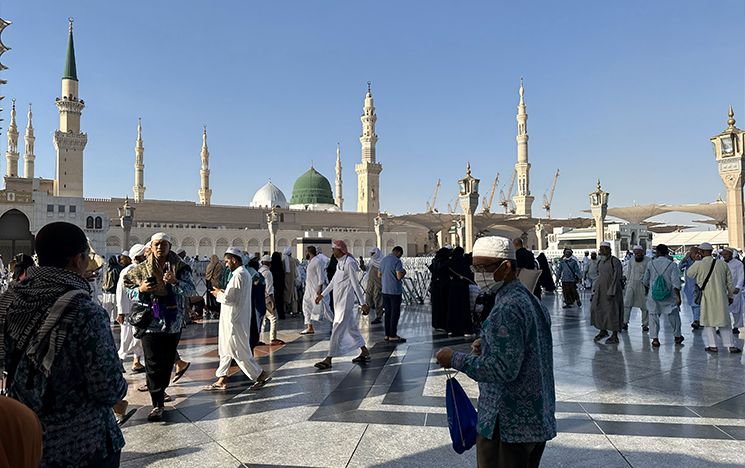
Figure 1. The Prophet Mosque Madina
The three holiest places in Islam are the Haram Al Sharif (literally translated as ‘the noble sanctuary’) in Mecca, Haram Al Sharif in Madina, and Al Haram Al Sharif in Jerusalem (also known as the Al Aqsa Mosque). For all Muslims, performing Hajj - religious pilgrimage to Haram Al Sharif in Mecca - is mandatory at least once for all those who are physically and financially able, though Muslims also visit Haram Al Sharif in Madina as part of the same pilgrimage to visit the Prophet’s Mosque, tomb, and other highly significant religious heritage connected to the Prophet and his companions. Originally, the Hijaz region containing both Mecca and Madina sites were not part of Saudia Arabia but were added to the Kingdom in 1932.
Hajj can only be performed once a year, during the last month of the Islamic lunar calendar. Given the high number of Muslims wishing to attend this short annual event, there is a global online lottery system that is targeted for those Muslims who live in the West and in Oceania. Umrah is a pilgrimage to Mecca and Madina that can be performed at any time of the year, one that I performed in August 2023.
Madina is where the Prophet Mohamed migrated with his family, companions, and followers in 622 CE to escape persecution endured in Mecca. The Prophet himself participated in building the Mosque, that also functioned as a community center, law court, and religious school. It contained a minbar (pulpit) for the Prophet to deliver the Friday address.
Madina is a remarkable city of Domes, in the middle of palm date fields and surrounded by mountains. The first of Madina’s famous Domes was built in 1279 CE (678 HJ), during the rule of the Mamluk Sultan Al Mansur Qalawun, and on top of Aisha’s home, the Prophet’s wife. Subsequently, the tombs of the Prophet, and the first two Caliphs who followed after the Prophet’s death were built of wood and later, after renovation, painted white and blue.
The Mosque and the Dome were destroyed by fire in 1481 CE, after which Sultan Qaitbay funded a renovation project. The present Dome was built by the Ottoman Sultan Mahmud II and painted its current color, green, in 1837. When Al Saud entered Madina in 1925, they destroyed almost all the cities’ famous Domes to prevent their adoration. They also stripped the Prophet’s tomb of all silver and gold objects, but the Prophet’s Dome escaped their destruction.
Going on the Umrah
With a group of fifty Muslims from various places including Birmingham, Leicester, and London in UK, we travelled by coach from Jeddah domestic airport to Madina for the Umrah in the sweltering month of August 2023. To this day, Madina still lies in the middle of mountains and date palm farms whose dates are famous for their quality. The tour operator I booked with is based in Small Heath, Birmingham and he travelled with us, along with a Sheikh who studied in Madina, and was deeply knowledgeable about the rituals, language, history and region.
Our hotel was a few minutes from Haram Al Sharif; so close that we could hear the Azan (call to the prayers) from our rooms as a daily reminder of our foremost reasons to be on the tour. After a few days we were joined by another group of ten who travelled from Birmingham and Derby and together we attended all five daily prayers at the Mosque
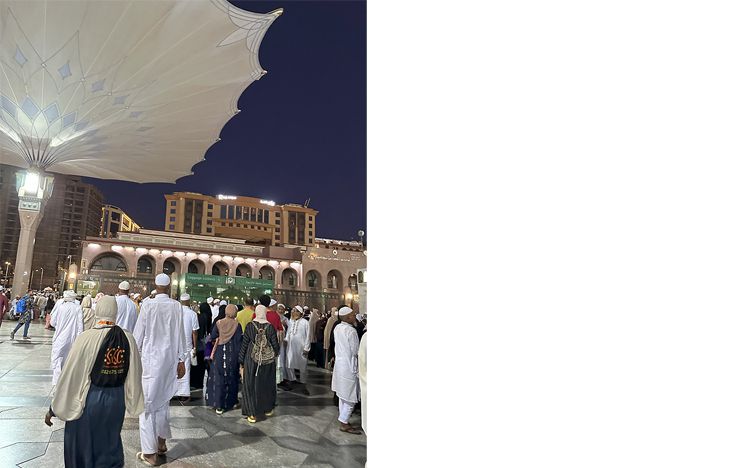
Figure 2. Worshipers’ early arrival to secure the perfect space 3:55 am, Madina
At the Mosque, we heard a variety of accents, dialects, and languages from all over the world. It was always packed, as other groups from Indonesia, Malaysia, Central and West Asia came in their thousands. Some of them told me they had been in Mecca since the Hajj, having spent thirty days in Mecca, followed by another ten days in Madina, before flying back home. Some Muslims slept in the Mosque, typically those that live far from the Holy sites, and who do not have the time and/or money to spend on transport back to their hotel every day and risk missing one of the five daily prayers.
The indoor courtyards of the Mosque are covered with sparkling white marble, gorgeous marble columns decorated with gold around the base and gold hand-crafted lights on the crown.
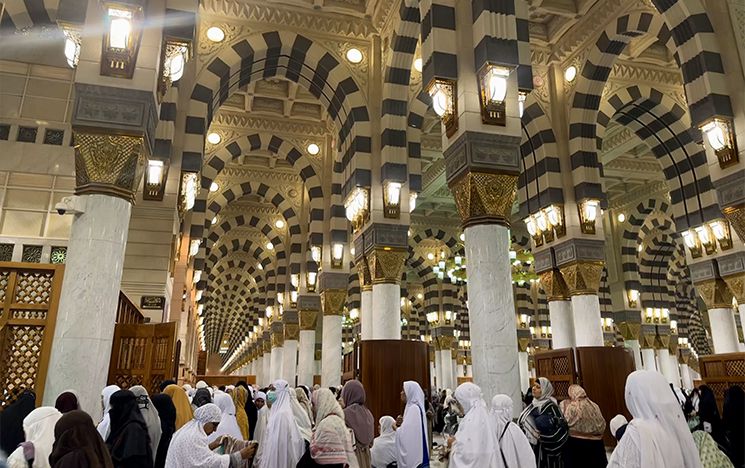
Figure 3. Remarkable decoration
Outdoor courtyards are covered with marble sculpted parasols in the shape of palm leaves and air-conditioned courtyards and water vaporizing, rose-scented ‘mist’ machines, which I was told by a shopkeeper are specially made for the Mosque The machines keep pilgrims cool in the summer heat while periodically releasing the scent of roses that both perfumes and disinfects the area.
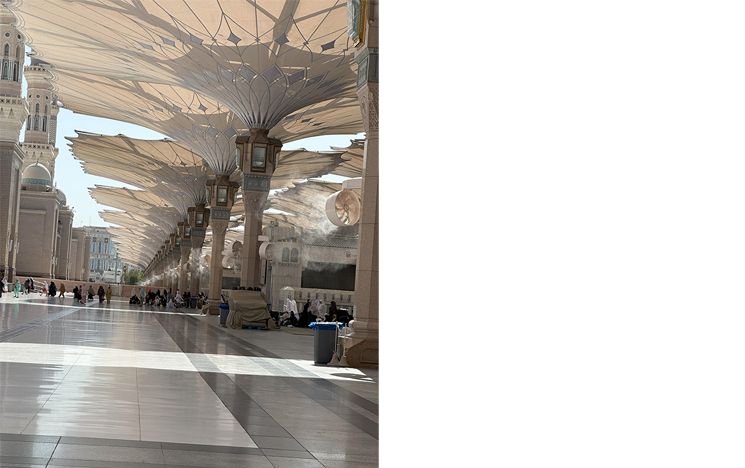
Figure 4. Shaded courtyard
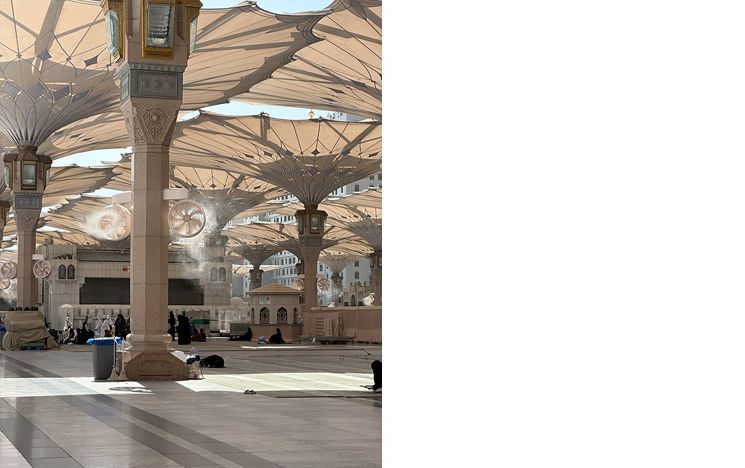
Figure 5. Air conditioning all day long
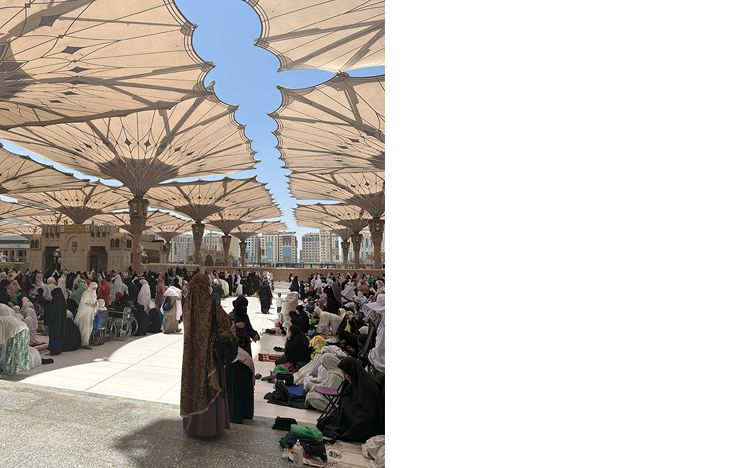
Figure.6. Scented sprinklers
The entire site is spotless, with cleaners at work 24 hours a day in eight-hour shifts. And pilgrims are kept hydrated with holy Zamzam water available all day and night. Water bottles and disposable cups are also provided, and the team is constantly supplying, picking up cups and emptying the bins.
Expanding Provisions for the Guests of Allah
The Prophet’s Mosque was the first place in the Arabian Peninsula to have electric lights, as early as 1909 CE (1327 AH). Today the Mosque shines bright at all hours of the day and night, with every inch of the walls, roof, indoor and outdoor facilities, courtyard, and streets surrounding the Mosque, open and lit 24 hours a day, 365 days a year. The Prophet’s Mosque underwent several expansions over the centuries during the rule of the Caliphs and the Umayyad, Abbasid, and Ottomans. Finally, the Saud Family oversaw the largest expansion in 1905, 1994 and 2012 to the present.
The Madina Mosque was extended to hold between 1.6-2 million pilgrims. Over 15 million worshipers prayed at the Prophet’s Mosque during the first half of Ramadan – that is, over 1 million worshipers per day for the five daily prayers, Hajj and Umrah augment Saudi Arabia's annual income and contributes greatly to the Saudi economy and employment. However, during the COVID-19 pandemic, the Mosque was closed on 5th March 2020 and Umrah visas were cancelled. As a consequence, the Mosque that does not sleep was forced to close its doors for worshippers.
Umrah resumed in October 2020, but was available only to Saudi citizens and residents. Hajj visas were restricted to only 10,000 worshipers in 2020 and 60,000 in 2021. Staff told me that generous donors provided free iftar every day of Ramadan for the guests of Allah – the meal eaten after sunset. Ramadan was also the time when local residents bring their food to share as Ramadan is the time of giving and sharing., In 2023, 250,000 free iftar meals were provided in the Prophet’s Mosque daily by generous business owners and residents.
Qurans in all sizes of print and prayer mats are available throughout the Mosque. Outside are shoe stands, and throughout are staff to help manage the flow of pilgrims. At every point in the Mosque at every gate, in front of the praying areas and in the courtyards are police wearing one of three uniforms. One force is responsible for security inside the Mosque, another for outdoor areas and the gates, and the third for traffic. Alongside are medical emergency teams and an office and police car to help locate lost individuals or groups. Fortunately, none of our group got lost.
A First Timer Experience
When I asked Mosque guards and some local residents about international pilgrim tours, they told me that the busiest times were the months of Ramadan and Maharam (the second holiest month in Islam after Ramadan when I was travelling). Due to the crowding, our group leader advised us to be at the Mosque by 10 am to secure a place inside, in order to avoid the 49-degree heat before Friday prayers just after noon. Leaving early, I arrived at 10 am to find the women’s entrance already closed, due to overcapacity.
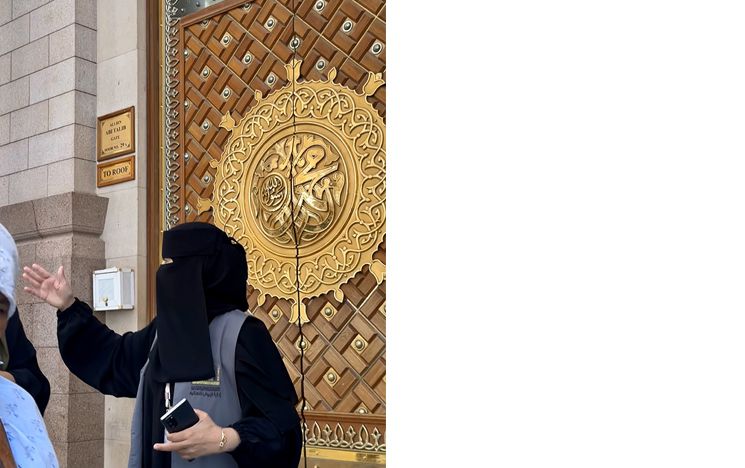
Figure 7. Strict crowed control. Mosque at maximum capacity, no entry
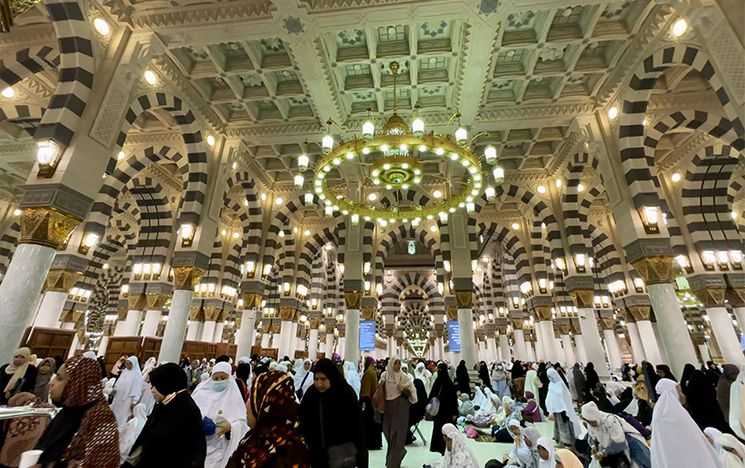
Figure 8. Friday prayers, struggle to find space even in the courtyard
It wasn’t just inside the Mosque but every inch of shade under the umbrellas in the courtyards was occupied. The throng extended to the doorsteps, which I managed to squeeze onto, shoulder to shoulder with my fellow pilgrims. Above our heads, men stood on the flat, hand-railed roofs, and beneath us, rugs extended outside of the Mosque gates onto the street and pavements around it.
Al-Rawdah Al-Sharifa Rawdah is an area within the Mosque, between the Prophet’s tomb and the minbar, where he used to give his Friday address (Khutba). Pilgrims visit the Rawdah to pray and make appeals with the belief that any prayers made in the Rawda will be granted.
Due to the high numbers of visitors, and the very limited space, entrance to the Rawdah is gated by technology booked online via the Saudi Nusuk system that is downloadable as an app on your phone. Even with this, entrance is not always guaranteed. Our tour guide advised the group to check the app every hour before we travelled and continue to do so if we failed to secure a slot. And while we diligently checked, we did not get a slot.
However, at 2.30 am I got lucky. Having checked again right after a lengthy wait. After Fajr prayers, one of the female guards in the Mosque started shouting ‘Rawdah, Rawdah’ in both Arabic and Urdu, and as a large number gathered, we waited. At 6.30 am, we all entered the Rawdah. Sometimes the old systems work best.
As we finally walked into the beautifully decorated Rawdah.
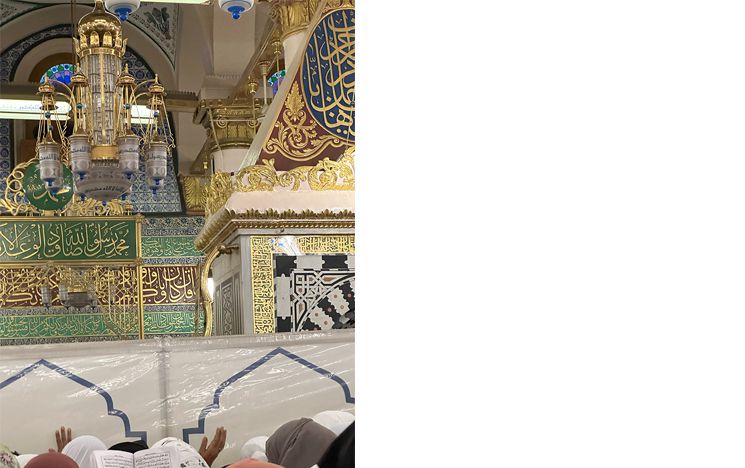
Figure 9. By stroke of luck, I got into Al Rawda Al Sharifa
The incoming row for people was chaotic, with people entering and existing via the same door, some people sitting and praying, and others crying, overwhelmed with the weight of the experience.
Two places I would have loved to visit were the Prophet’s tomb and Al Bagi cemetery. However, the authorities prohibited women from visiting the Prophet tomb. The Al Bagi cemetery is where the Prophet’s family and thousands of the Prophet’s companions and followers are buried. There, following tradition, you would say a prayer - as the Prophet once did - every time you passed. However, women weren’t allowed entrance to either place.
While female entry is barred, I asked one of the cemetery guards and some Madina residents if I could catch a glimpse of the cemetery and take a photograph through the fence. But due to large building extensions to the Mosque, all lines of sight are currently blocked.
I was disappointed. Family members and friends had asked me to pray for them when I visited the Prophet's Tomb as all wishes and prayers will be granted.